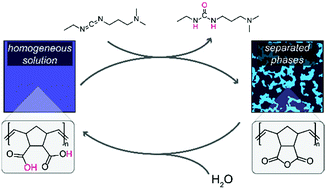Spinodal decomposition of chemically fueled polymer solutions†
Abstract
Out-of-equilibrium phase transitions driven by dissipation of chemical energy are a common mechanism for morphological organization and temporal programming in biology. Inspired by this, dissipative self-assembly utilizes chemical reaction networks (CRNs) that consume high-energy molecules (chemical fuels) to generate transient structures and functionality. While a wide range of chemical fuels and building blocks are now available for chemically fueled systems, so far little attention has been paid to the phase-separation process itself. Herein, we investigate the chemically fueled spinodal decomposition of poly(norbornene dicarboxylic acid) (PNDAc) solution, which is driven by a cyclic chemical reaction network. Our analysis encompasses both the molecular level in terms of the CRN, but also the phase separation process. We investigate the morphology of formed domains, as well as the kinetics and mechanism of domain growth, and develop a kinetic/thermodynamic hybrid model to not only rationalize the dependence of the system on fuel concentration and pH, but also open pathways towards predictive design of future fueled polymer systems.



 Please wait while we load your content...
Please wait while we load your content...